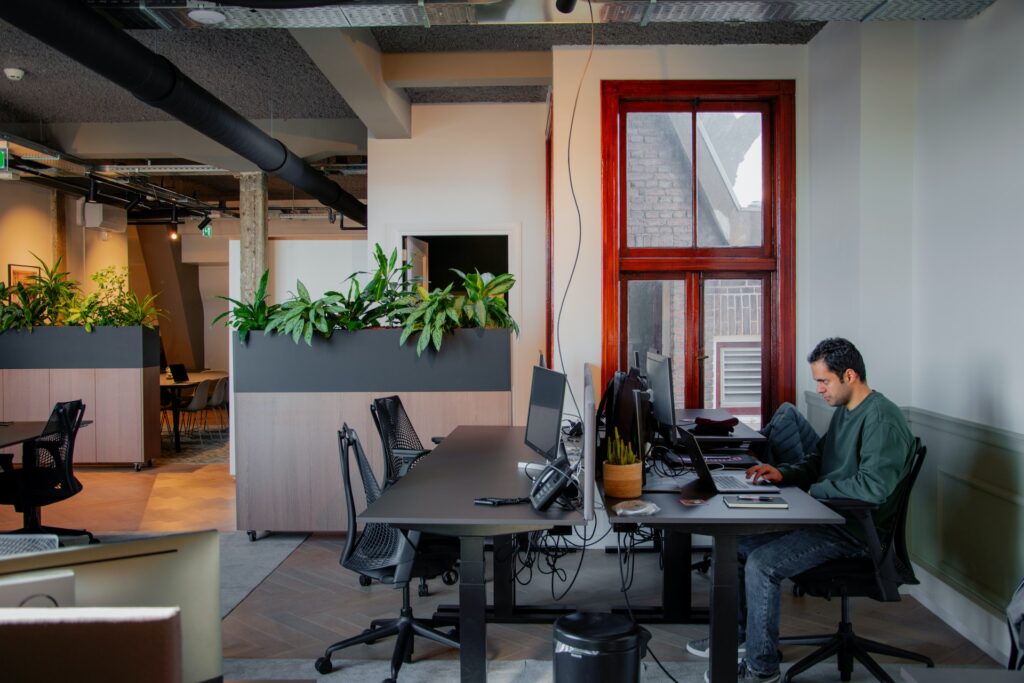Get Started now!
ezeep Blue is completely free for up to ten users. Sign up and get started with just a few clicks.

Hot desking is rapidly gaining popularity in the hybrid workplace, offering both advantages and disadvantages for companies. This desk-sharing strategy, where employees do not have fixed workspaces but instead choose an available desk upon arrival, has become a cornerstone of modern office environments. By rotating desk assignments, hot desking introduces a flexible, dynamic workspace that encourages collaboration and efficient space utilization. We’ll explore the benefits of hot desking and its downsides today as well as look at the hot desk vs. hoteling viewpoints.
While hot desking and hoteling share similarities, it’s essential to differentiate between the two. Hot desking allows employees to choose any available workspace, while hoteling involves reserving a specific desk in advance. Both methods aim to optimize office space, but hotel desks offer a structured approach, ensuring employees have a designated spot, similar to booking a hotel room. This distinction highlights the varying degrees of flexibility and planning required by each method, particularly in a hybrid work environment.
The advantages of hot desking to the employee are numerous. It fosters a sense of equality and collaboration by allowing employees to work alongside different colleagues daily. This promotes cross-departmental communication and the exchange of ideas, which can enhance creativity and productivity. Additionally, it caters to the needs of more mobile employees, who may not require a permanent desk, thus supporting a flexible working style.
For employers, the benefits of hot desking are equally compelling. It maximizes office space efficiency by reducing the number of desks needed, leading to significant cost savings—up to 30% compared to conventional office setups. Moreover, hot desking supports a dynamic and adaptable workforce, which is increasingly important in today’s fast-paced business environment.

Time's up
Despite the benefits of hot desking, it does present challenges. One of the primary hot desking disadvantages for the employer is the potential decrease in employee satisfaction due to the lack of personalized spaces. Employees may miss the comfort of a personal desk, which can be addressed by offering storage solutions like smart lockers or cubbies for personal items.
Another concern is hygiene, particularly in a health-conscious world. Regular cleaning protocols and the provision of sanitizing products can help alleviate these worries. Additionally, the dynamic seating arrangement can lead to increased distractions. Employers can counter this by creating quiet zones or rooms for focused work.
When comparing hot desk vs. hoteling, each approach has its unique advantages. Hot desking offers more flexibility, while hoteling provides a more structured environment. The choice between the two depends on the specific needs of the company and its employees.
There’s also the logistical challenge of ensuring everyone has the resources they need, ranging from enough coffee to connecting the right printers, no matter where they sit.
In hot desking environments, printing can pose a logistical challenge. Solutions like ezeep Blue offer cloud-based printing that supports dynamic workspace setups. Employees can print to any available printer near their chosen desk, ensuring flexibility and security. Features like AnyPrinter and Print Later enhance convenience and protect confidential documents, making ezeep Blue an ideal choice for companies adopting hot desking. The platform is also compatible with Azure Virtual Desktop, Windows 365 Cloud PC or other workspace virtualisation tools from Citrix or VMware and supports a broad range of devices and printers.
In conclusion, while hot desking presents certain challenges, the advantages of hot desking far outweigh the disadvantages when implemented correctly. Companies can enjoy significant benefits, such as reduced costs and enhanced collaboration, by addressing potential drawbacks with thoughtful planning. For businesses looking to adopt hot desking, options like ezeep Blue’s cloud-managed printing solution will streamline the transition, particularly in managing printing needs within a hybrid workspace.
This is one of a series of posts focusing on hot desking. You can learn more and read the other posts here:
ezeep Blue is completely free for up to ten users. Sign up and get started with just a few clicks.